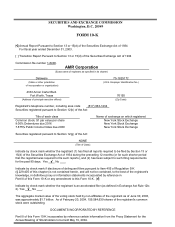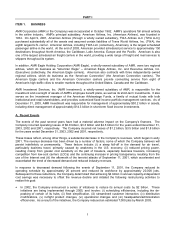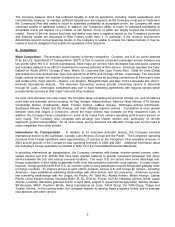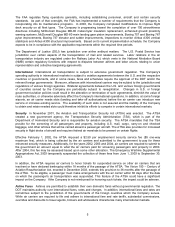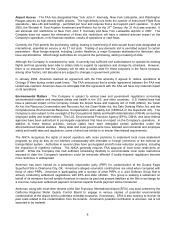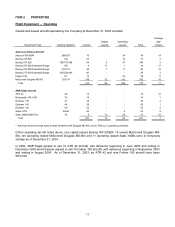American Airlines 2003 Annual Report Download - page 5
Download and view the complete annual report
Please find page 5 of the 2003 American Airlines annual report below. You can navigate through the pages in the report by either clicking on the pages listed below, or by using the keyword search tool below to find specific information within the annual report.
3
The Company believes that it has sufficient liquidity to fund its operations, including capital expenditures and
commitments. However, to maintain sufficient liquidity over the long-term as the Company continues to implement
the Turnaround Plan and seeks to return to sustained profitability at acceptable levels, the Company will need
continued access to additional funding. In addition, the Company’s ability to return to sustained profitability at
acceptable levels will depend on a number of risk factors, many of which are largely beyond the Company’s
control. Some of the risk factors that have had and/or may have a negative impact on the Company’s business
and financial results are discussed in Risk Factors under Item 7. In particular, if the revenue environment
deteriorates beyond normal seasonal trends, or the Company is unable to access the capital markets, it may be
unable to fund its obligations and sustain its operations in the long-term.
B. Competition
Major Competitors The domestic airline industry is fiercely competitive. Currently, any U.S. air carrier deemed
fit by the U.S. Department of Transportation (DOT) is free to operate scheduled passenger service between any
two points within the U.S. and its possessions. Most major air carriers have developed hub-and-spoke systems
and schedule patterns in an effort to maximize the revenue potential of their service. American operates five hubs:
Dallas/Fort Worth (DFW), Chicago O'Hare, Miami, St. Louis and San Juan, Puerto Rico. Delta Air Lines (Delta)
and United Air Lines (United) also have hub operations at DFW and Chicago O'Hare, respectively. The American
Eagle carriers increase the number of markets the Company serves by providing connections at American’s hubs
and certain other major airports -- Boston, Los Angeles, Raleigh/Durham and New York’s LaGuardia and John F.
Kennedy International Airports. The American Connection carriers provide connecting service to American
through St. Louis. American's competitors also own or have marketing agreements with regional carriers which
provide similar services at their major hubs and other locations.
On most of its domestic non-stop routes, the Company faces competing service from at least one, and sometimes
more than one domestic airline including: AirTran Airways, Alaska Airlines, America West Airlines, ATA Airlines,
Continental Airlines (Continental), Delta, Frontier Airlines, JetBlue Airways, Northwest Airlines (Northwest),
Southwest Airlines, United and US Airways, and their affiliated regional carriers. Competition is even greater
between cities that require a connection, where the major airlines may compete via their respective hubs. In
addition, the Company faces competition on some of its routes from carriers operating point-to-point service on
such routes. The Company also competes with all-cargo and charter carriers and, particularly on shorter
segments, ground transportation. On all of its routes, pricing decisions are affected, in large part, by the need to
meet competition from other airlines.
International Air Transportation In addition to its extensive domestic service, the Company provides
international service to the Caribbean, Canada, Latin America, Europe and the Pacific. The Company's operating
revenues from foreign operations were approximately 27 percent of the Company’s total operating revenues in
2003 and 28 percent of the Company’s total operating revenues in 2002 and 2001. Additional information about
the Company's foreign operations is included in Note 14 to the consolidated financial statements.
In providing international air transportation, the Company competes with foreign investor-owned carriers, state-
owned carriers and U.S. airlines that have been granted authority to provide scheduled passenger and cargo
service between the U.S. and various overseas locations. The major U.S. air carriers have some advantage over
foreign competitors in their ability to generate traffic from their extensive domestic route systems. In many cases,
however, foreign governments limit U.S. air carriers' rights to carry passengers beyond designated gateway cities
in foreign countries. To improve access to each other's markets, various U.S. and foreign air carriers - including
American - have established marketing relationships with other airlines and rail companies. American currently
has marketing relationships with Aer Lingus, Air Pacific, Air Tahiti Nui, Alaska Airlines, British Airways, Cathay
Pacific, China Eastern Airlines, Deutsche Bahn, EL AL, EVA Air, Finnair, Gulf Air, Hawaiian Airlines, Iberia, Japan
Airlines, LanChile, Mexicana (planned launch in April 2004, subject to governmental approvals), Qantas Airways,
SN Brussels, SNCF, Southern Winds, Swiss International Air Lines, TACA Group, the TAM Group, Thalys and
Turkish Airlines. In the coming years, the Company expects to develop these programs further and to evaluate
new alliances with other carriers.


